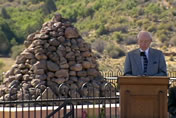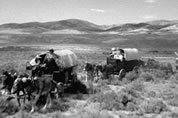Burying the Past: Legacy of the Mountain Meadows Massacre


In 1857, over one hundred people were massacred as they made a trip from Arkansas to California. Ever since, the details of what actually happened have been shrouded in controversy. Many claim that the killers were members of the Church of Jesus Christ and Latter Day Saints, or, as they are also known, the Mormons. The Mormons have vigorously denied this, as expected. After all, theirs if a faith built on community. Their love of family is one of the big reasons that people join their church. On a purely cynical note, it would not behoove the Mormons to acknowledge a vicious massacre (the largest killing of Americans by Americans until the Oklahoma bombing). Brian Patrick's documentary, Burying the Past: Legacy of the Mountain Meadows Massacre attempts to unravel the various threads of rhetoric on both sides to get to what truly happened.
There is no dispute that these people died horribly. Everybody except for some young children were slaughtered. These young children grew up to provide chilling first person accounts of what happened, and their descendants kept the memory of the tragedy alive. Mountain Meadows is in Utah, and the various families were traveling through a heavily Mormon area. Locals claimed that Indians were responsible for the massacre, while the survivors claimed that Mormons dressed as Indians were responsible. Worse, the survivors claimed that the Mormons allowed the wagon train to surrender and then slaughtered them. Nearly 150 years later, it still weighs powerfully on the descendants.
Patrick (It All Started Here, Encounter) interviewed reporters, descendants, and one Church member, and the one flaw in Burying the Past is the lack of breadth in his interviews. He weaves together a compelling narrative, but the documentary seems a little one-sided. Granted, the lion's share of the evidence points to Mormon involvement. It would have been nice to see more than two historical experts, and really nice to see expanded interviews with the Church, who did their best to provide neutral, politically correct answers. The survivors are a different story. They are a mixed bunch, some of whom just want acknowledgement of what happened, and others who want to go after the church for their actions. The truth seems to be somewhere between the two extremes. Mormons back then were a wary lot. They suffered persecution at the hands of many, and were slowly driven across the country. The likely explanation is that they were extremely suspicious of the wagon train and things went too far. The next step is determining who was responsible, and how far up the church hierarchy the knowledge went. Patrick has some damning evidence pointing out that it went pretty high.
A lot of Burying the Past deals with the construction of a monument to honor the dead, and the contention surrounding it. The LDS Church was to be in charge of the upkeep of the monument, which understandably irked many of the descendants. The LDS Church initially tried to whitewash any mention of the word "massacre," which gutted the emotional impact of the monument. Later, once they broke ground, they discovered the remains, and opened up a whole new metaphorical can of worms. Good scientific research could help determine what happened. Scientists did find bullet holes entering from the backs of skulls. However, the descendents objected to Brigham Young University examining the remains because of its affiliation with the Mormon Church. Later, the descendants, a rural, traditional, people, wanted no additional work performed on the bones, and wanted them buried before tests were complete. They are, in essence, preventing themselves from a better understanding of the events. In the end, while it does matter who is responsible, Burying the Past is important because it sheds light on a subject that few knew about before. The death of 120 people in one fell swoop is a big thing, and Patrick's documentary is a good first step in recording this for the world to see.